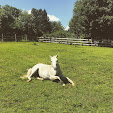My father and I arrived in Chicago Friday night. My mom had arrived the day before, along with her sisters and several of her nieces, to see the city. We stayed at the hotel where the reception was held, which was one of those nice hotels with a indoor "courtyard" type of space, with the rooms circling the courtyard. I hadn't brought my French siddur with me, so I looked for the next best thing — a Gideon Bible, and skipped past the lists of suggested passages (many having to do with temptation) to the Psalms. The sun was shining, and all was still, but the day would quickly become filled with excited moving about.
My mom and I, and some of my sister-in-law's friends were helped with our saris. There are three pieces of the post-British Empire sari: the choli (short-sleeve, v-neck midriff blouse), the petticoat (a long drawstring skirt) and a very, very long piece of colorful fabric. which is elaborately folded and draped. For white women who are relatively inexperience with saris, there is an important fourth piece: safety pins, which help keep the folds looking nice. Many Indian women also use safety pins, but not as many as my mom and I did. The pins, and tying my petticoat drawstring to near-Victorian tightness, kept my sari looking put together. My mom had a red-purple sari with wavy gold/purple trim and mine was dark red with gold and green trim. We also had sparkly necklaces and bangles (of course).
My parents, my mom's relatives, several family friends, and I went to the temple in a fancy bus after spending several minutes admiring each other's outfits. At the temple, we had a quick breakfast before moving upstairs. I was trying to figure out how to walk in the sari without tripping over the floor-length hem, when the wedding planner arrived with a headset to arrange the procession of the groomsmen (all in matching tunic/pant/scarf outfits), groom and groom's family. The bridesmaids wore trendy saris (the ones with bra-level cholis and semi-sheer fabric as opposed to the more traditional opaque silk and waist-level cholis) in similar shades of teal to the bride's mother's sari (which was teal and lime green).
The room where the ceremony was held was a cinderblock auditorium. The walls been beautified with extensive white drapes, and a green/white draped with rose petals ran down the center. On each side of the center aisle were rose-orange balls of carnations on metal stands, with green and white drapes hanging between them. The platform on which the ceremony was held had lots of fine white drapes as its backdrop, with strung yellow flowers hanging in front of the drapes. On the platform itself was the sacred fire (in an ornate metal box), a basket of fruit, and several small bowls with yellow and red spices. In the middle was a large chair with red cushions. My parents and I sat on the platform stage right, and the bride's parents sat stage left, with the bride's brother standing behind them. My brother sat in the large chair. One of the bride's uncles, who is an engineer but is also religiously learned, conducted the ceremony.
During the first part of the ceremony, the bride's parents persuade the groom to marry their daughter, and the groom is treated like a king. A dark red turban with beads and embroidery is placed on his head, and spices are spotted on his feet and necklace. As the priest explained that on his wedding, the groom becomes king of the universe, my brother was visibly beaming. My parents and the bride's parents, along with my brother, wore red, white, and green flower garlands. My parents' garlands were made of carnations, and the bride's parents' garlands were made of folded rose petals (the effect was that the folded petals looked like exotic puffy flowers, for lack of a more eloquent description).
Before the bride arrives, escorted by two of her uncles, a semi-sheer orange screen was held up so that my brother would not see her. My parents and I tried to see her, but were just outside the line of sight. The screen was lowered, so that my brother and the bride could see each other. The bride's father then asked, three times, that my brother not transgress the bride in dharma, wealth, and the enjoyment of wealth (for Jewish readers, think about the parallel between the groom's basic obligations here and Jewish husbands' legal obligations to provide for and protect their wives).
My brother placed a wedding necklace over the bride's head. Clarified butter was poured over the sacred fire. After that, my brother put toe rings on the bride (apparently he didn't understand how to adjust them at first, so there was a good laugh about this). The couple took seven steps around the sacred fire, lead by the bride's brother, who held up a lemon on a knife. Traditionally, the bride's brother would lead the bride and groom to their new home, and the knife carried in case of wild animals. The couple exchanged vows, and held hands in a special way (to distinguish this hand-holding from a hand-shake or friendly hand-holding).
After the ceremony, the couple sat in two chairs below the platform to be blessed by the guests, who also sprinkled them with petals. My parents and I stood with them for a while, and also halfway down the aisle. There were about 500 guests to the reception, and 300-400 at the wedding (I'm bad at estimating really large crowds), so this part took a long time. In addition to waiting for our turn to be photographed, we stayed in the auditorium about an hour and a half after the ceremony. By the time we went downstairs for lunch (1:30-ish) we weren't actually that hungry between the general excitement and saving room for dinner.

No comments:
Post a Comment